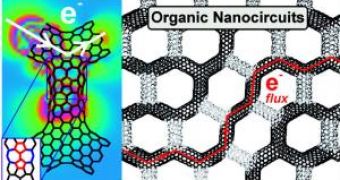Perfection does indeed come from flaws, as a new discovery in the fields of nanotechnology and energy conductivity indicates. Namely, a team of US experts managed to alter the internal structure of carbon nanotubes that typically behaved as insulators so that now it performs better than the traditionally-used silicon in transmitting electrical charges. To put it rudimentarily, it looks like some sort of microscopic labyrinth game.
Individual nanotubes are excellent conductors, since they represent a single carbon molecule, so circuits made of nanotubes should behave much in the same way, just like metal wire circuits. But practice reveals this to be wrong. The internal structure of a carbon nanotube reveals that the carbon atoms are arranged in hexagonal lattice patterns, much like a honeycomb. This creates Y junctions that the current must cross (see the adjacent picture). And these "connections between individual nanotubes do not conduct well," explains Vincent Meunier from Oak Ridge National Laboratory in Tennessee.
Electrons interpret the junctions as barriers, and as they travel along one prong, they perpendicularly hit the far wall and bounce back along the same nanotube, acting like an insulator, in an effect experts call "opaque". But changing the hexagonal shape (transforming it into a heptagon or a pentagon) changes the angle of the electron's impact and redirects it further along a predetermined path. Only two defects added to the end of a tube with the help of a focused electron beam allow for a small amount of certain current strengths, but adding more enables almost any kind and amount of current to jump over to the next tube.
"Then you can start to make all kinds of things," states Meunier, cited by New Scientist. "You could make really complicated networks." Chuanhong Jin, from the National Institute of Advanced Industrial Science and Technology in Tsukuba, Japan, shares his excitement, "This is a very interesting theoretical proposal for designing new carbon nanotube-based 3D nano-circuits. The method should be of particular importance for the realization of the long-expected all-carbon programmable nano-electronics circuits".

 14 DAY TRIAL //
14 DAY TRIAL //